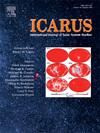Ultrasonic velocities of icy powdered rock with implications for seismic resource exploration on the moon
IF 2.5
2区 物理与天体物理
Q2 ASTRONOMY & ASTROPHYSICS
引用次数: 0
Abstract
Although water ice has been detected by satellite observations near the lunar poles, it is unknown if this ice is simply frost on the Moon's surface or if larger ice deposits exist in the subsurface. If ice is present within the subsurface, it is unknown if this ice exists as loose ice grains or as a cement that binds regolith grains together. To create an economically viable extraction and production plan for lunar water ice resources, we must characterize near-surface ice concentration and distribution at small (<10 m) spatial and depth scales. Geophysical methods that can be deployed on the Moon's surface, such as seismic surveying, could supply some of this information for future lunar mine planning. To improve our understanding of how seismic surveying may detect and characterize subsurface lunar ice, we performed laboratory ultrasonic velocity measurements of lunar regolith simulant with variable amounts of granular and cementing ice. These measurements were performed under variable confining pressure (0.005–0.08 MPa) and constant low temperature (−26 °C). We used these measurements to calibrate a rock physics model to predict seismic velocity as a function of porosity, pressure, ice concentration and ice texture. Our results show that seismic velocity increases with ice concentration, and this increase is roughly 20 times higher for cementing ice than for granular ice. Our model can be used in future studies to predict how effective seismic methods may be for detecting and characterizing subsurface lunar ice deposits with varying ice properties and geologic complexity.
求助全文
约1分钟内获得全文
求助全文
来源期刊

Icarus
地学天文-天文与天体物理
CiteScore
6.30
自引率
18.80%
发文量
356
审稿时长
2-4 weeks
期刊介绍:
Icarus is devoted to the publication of original contributions in the field of Solar System studies. Manuscripts reporting the results of new research - observational, experimental, or theoretical - concerning the astronomy, geology, meteorology, physics, chemistry, biology, and other scientific aspects of our Solar System or extrasolar systems are welcome. The journal generally does not publish papers devoted exclusively to the Sun, the Earth, celestial mechanics, meteoritics, or astrophysics. Icarus does not publish papers that provide "improved" versions of Bode''s law, or other numerical relations, without a sound physical basis. Icarus does not publish meeting announcements or general notices. Reviews, historical papers, and manuscripts describing spacecraft instrumentation may be considered, but only with prior approval of the editor. An entire issue of the journal is occasionally devoted to a single subject, usually arising from a conference on the same topic. The language of publication is English. American or British usage is accepted, but not a mixture of these.
 求助内容:
求助内容: 应助结果提醒方式:
应助结果提醒方式:


